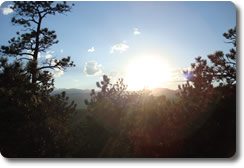 Welcome to my Practice for Craniosacral Therapy and Birth Integration.
Welcome to my Practice for Craniosacral Therapy and Birth Integration.
I want to share with you some information about my background to let you know the influences on my work.
The heart of my practice is Craniosacral Therapy with all its layers, combined with Birth Integration Therapy, and counselling. I not only love what I’m doing, I also want to share what I know. This is why I am a teacher of Craniosacral Therapy as well.
I love studying and expanding my knowledge and experience. Everything I am learning is beneficial to the work I do and influences the way I work with patients.
I can draw on my broad background in the healing arts from being a medical doctor with training in Chiropractic, Osteopathy, Trauma Therapy, and more. I am also greatly influenced by my experiences of being a musician and practicing Aikido.
My current practice is dedicated to preserve health from the beginning. This is why I especially work with babies and children. Treating them before minor imbalances have an opportunity to turn into bigger health problems is very valuable. Taking care of optimal health begins even earlier. I support families during their journey of preparing for conception and during their time of pregnancy, birth, and postpartum.
But Craniosacral Therapy as well as Pre- and Perinatal Therapy is beneficial for all ages.
Orthodox medicine
I am a medical doctor from Germany. Even though I don’t practice mainstream medicine anymore, I am very thankful for my thorough training and experience in the medical world. The understanding of anatomy, physiology, pathology, and embryology that it gave me is a solid foundation for my craniosacral and pre- and perinatal work. Internships at the children’s emergency room and the neonatal intensive care unit – the NICU – of a university hospital in Berlin gave me the chance to see very rare diseases, and to gain insights into the technological model of birth and care of premature babies. This is a great help for my work with families now. It gives me a better idea about what families are going through when they experience premature labor, induction, cesarean birth, or NICU. And it helps a lot in understanding what babies are communicating.
Thankfully I was also able to work together with midwives in a birthing center and at home births. That taught me more about natural birth and birth as a sacred transition.
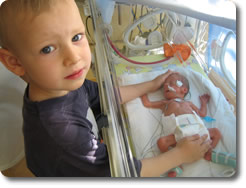
Chiropractic
Before I studied medicine, I was a pianist. This is why from the beginning of my medical training I knew that I wanted to use my highly trained hands to treat people. So in addition to studying medicine and becoming a medical doctor, I also became a Doctor of Chiropractic, providing this care to my hospital patients.
Osteopathy
One of my colleagues in the hospital where I worked was actually successful in cases other chiropractic doctors were not. When he introduced me to Osteopathy, I immediately knew that I had to learn this as well. In addition to being a fulltime doctor I studied Osteopathy, bringing back to my patients what I had learned.
Craniosacral Therapy
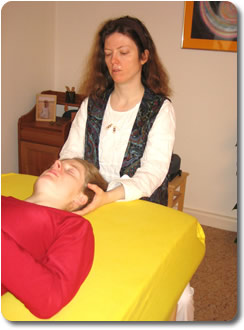 When I received my first craniosacral session, it felt like coming home, as if everything I did so far could be integrated into this method.
When I received my first craniosacral session, it felt like coming home, as if everything I did so far could be integrated into this method.
Fortunately for me, Wolfgang Rühle, the practitioner I saw, was not only a therapist but a teacher of Craniosacral Therapy as well. So my training could start right there. And we still share a wonderful and inspiring friendship. Soon I started assisting his training, enriching it with my medical background. Since 2005 I have been teaching classes at his School for Craniosacral Therapy Berlin that were already part of the training, as well as new ones I added, such as Craniosacral Therapy for babies and children, embryology, and cranial nerves. Wolfgang and I also experimented a lot with each other to explore new levels and possibilities, and to deepen the work or adapt techniques to craniosacral work in water.
I even did craniosacral work in the Atlantic Ocean, surrounded by wild dolphins.
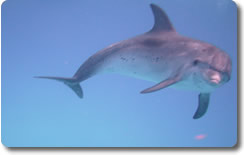 What you can achieve with Craniosacral Therapy depends a lot on the practitioner and their training and background. For me, I can integrate all my medical knowledge – and Craniosacral Therapy is like a framework for it. This framework includes not only expertise in anatomy, physiology, embryology, and so on, but also a respectful relationship with the patient, as well as acknowledging the soul level of the person and the inner wisdom of his body-mind connection. It is turning medicine into an art.
What you can achieve with Craniosacral Therapy depends a lot on the practitioner and their training and background. For me, I can integrate all my medical knowledge – and Craniosacral Therapy is like a framework for it. This framework includes not only expertise in anatomy, physiology, embryology, and so on, but also a respectful relationship with the patient, as well as acknowledging the soul level of the person and the inner wisdom of his body-mind connection. It is turning medicine into an art.
And because of its softness and gentleness, Craniosacral Therapy is especially suited for babies and children, while most chiropractic techniques are not. But of course it needs special training and experience to do Craniosacral Therapy with children, which I had in Germany as well as in the United States.
Psychology and Trauma Therapy
Psychology was another major I studied during college. It deepened my understanding for other people and enhanced my communication skills as well as gave me a foundational knowledge about child development. In addition, I received training in Psychological Trauma Therapy, called EMDR – Eye Movement Desensitization and Reprocessing. Together with basics about the trauma work Somatic Experiencing by Peter Levine, also known as SE work, it brought my craniosacral work to a new level, enabling me to not only work with the physical side of problems, but to also be of further assistance with the emotional challenges of my patients. And of course it is a very helpful background for working with babies and families, to help them integrate a traumatic birth experience or other early traumatic imprints.
Aikido
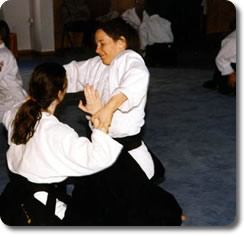 Further influences on my work come from music, dance, and Aikido. Practicing this non-violent martial art taught me how to step aside for a moment and look at a problem from a new angle and another perspective to find a solution. I learned a lot about energy work and being with the flow, finding the way of ease, and being in relationship. The principles of Aikido are very similar to the principles of craniosacral work and the art of healing. Practicing one of them automatically improved my experience in the other field.
Further influences on my work come from music, dance, and Aikido. Practicing this non-violent martial art taught me how to step aside for a moment and look at a problem from a new angle and another perspective to find a solution. I learned a lot about energy work and being with the flow, finding the way of ease, and being in relationship. The principles of Aikido are very similar to the principles of craniosacral work and the art of healing. Practicing one of them automatically improved my experience in the other field.
Becoming a first Dan, black belt, in Aikido taught me more about the value of keeping a beginner’s mind. Each level has its own challenges. And even as a black belt you have to be willing to fall hundreds of time and to give up things you already know, in order to explore a new dimension or new techniques.
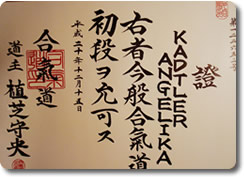
Aikido keeps you playful too, open for new ideas and perspectives.
I love to play with the children who come into my practice. It is a good way to bond and earn their trust, to build a relationship, which allows me to treat them and have not only the parent’s consent for the session, but also the child’s or even baby’s approval.
And it keeps my inner child alive, which helps me to relate to my young patients.
Piano and music
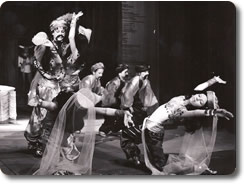 As a child, all the way up to high school, I was part of a children’s ballet with over 40 performances a year. And when I was 10 years old I started playing the piano. After high school I studied the piano for 6 years in college, and graduated with a degree in piano and teaching. High gifted children was the subject of my thesis.
As a child, all the way up to high school, I was part of a children’s ballet with over 40 performances a year. And when I was 10 years old I started playing the piano. After high school I studied the piano for 6 years in college, and graduated with a degree in piano and teaching. High gifted children was the subject of my thesis.
Because of my training in music and dance, I developed an understanding for harmony in ourselves, in our body-mind-soul system, and an understanding in the importance of communication.
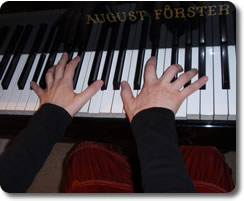 In Craniosacral Therapy we work a lot with the rhythmic systems of the body. My background as a musician included playing and analyzing polyphonic music, such as fugues by Bach. Having played fugues with 3, 4, or 5 themes at the same time seemed to be a perfect preparation for now being able to track different rhythms and movements in the human body at the same time. It is also useful for tracking what is going on in the baby, while simultaneously being able to notice what is going on with the other family members. Being a musician also means to practice medicine not only by using techniques and technology, but practicing it as an art.
In Craniosacral Therapy we work a lot with the rhythmic systems of the body. My background as a musician included playing and analyzing polyphonic music, such as fugues by Bach. Having played fugues with 3, 4, or 5 themes at the same time seemed to be a perfect preparation for now being able to track different rhythms and movements in the human body at the same time. It is also useful for tracking what is going on in the baby, while simultaneously being able to notice what is going on with the other family members. Being a musician also means to practice medicine not only by using techniques and technology, but practicing it as an art.
Accident and energy work
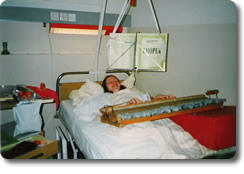 A severe bike-accident led to my career change from being a pianist to becoming a doctor. Knowing the experience of trauma and the way of healing is a huge benefit to me for being a doctor. It allows me to develop a better idea about how my patients might feel when they have to deal with pain, impatience, illness, loss… and with finding their personal way of healing.
A severe bike-accident led to my career change from being a pianist to becoming a doctor. Knowing the experience of trauma and the way of healing is a huge benefit to me for being a doctor. It allows me to develop a better idea about how my patients might feel when they have to deal with pain, impatience, illness, loss… and with finding their personal way of healing.
This accident also gave me the chance to experiment with energy work myself. I couldn’t imagine being apart from my piano for 3 months. Back then this was just out of the question. So I started to talk to my bones, asking them to grow together properly and quickly, visualizing how the cells were doing their work. According to normal medicine, a pelvic fracture needs about 12 weeks to heal. I surprised all the doctors. The check x-ray taken after only 4 weeks showed that my bones had already healed perfectly. This taught me a lot about the amazing healing power of our mind.
Teaching
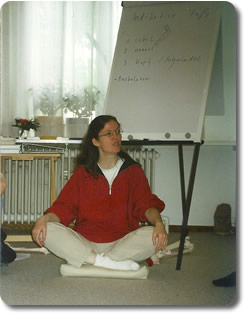 My training in pedagogy and didactics is a perfect foundation for my passion to teach. I love what I’m doing and I want to share what I know. As long as I can remember, I was not only studying but also teaching. During school, college, and med-school, I was tutoring others. I taught piano and Chiropractic. I gave lectures at medical conferences, taught Craniosacral Therapy and Pre- and Perinatal Therapy.
My training in pedagogy and didactics is a perfect foundation for my passion to teach. I love what I’m doing and I want to share what I know. As long as I can remember, I was not only studying but also teaching. During school, college, and med-school, I was tutoring others. I taught piano and Chiropractic. I gave lectures at medical conferences, taught Craniosacral Therapy and Pre- and Perinatal Therapy.
In my new practice I teach Craniosacral and Birth Integration Therapy, as well as childbirth education. I teach parents how to communicate with their babies before and after birth. I also offer supervision for craniosacral practitioners, and for other professionals who work with babies and children.
And of course my teaching background also helps me to explain medical knowledge in understandable words to my patients.
Dissertation
In the beginning of my medical career, I not only wanted to bring the world of music and medicine together by treating many professional musicians, I also wanted to keep the bridge between the academic world and my work in alternative medicine. So I did a research project about how professional musicians cope with stress, and how this influences their performance and overall health. I tested 80 musicians under standard conditions. I then picked 12 of them according to certain criteria. I followed them on different concert days, while measuring their physiological regulation with certain parameters, as well as their anxiety level, in order to verify the findings and hypotheses from the lab within the actual musician’s life.
Birth Integration Therapy
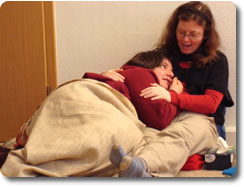 The most amazing part of my journey in the medical field is the continuing discovery of the pre- and perinatal world. While working with babies, I learned pretty quickly that my own early imprints influenced the way I interacted with babies. Integrating my own story and making sense out of it enabled me to be present and 100% there for the baby I work with, having compassion and empathy for what they might have had to go through in order to come here.
The most amazing part of my journey in the medical field is the continuing discovery of the pre- and perinatal world. While working with babies, I learned pretty quickly that my own early imprints influenced the way I interacted with babies. Integrating my own story and making sense out of it enabled me to be present and 100% there for the baby I work with, having compassion and empathy for what they might have had to go through in order to come here.
In countless fascinating workshops I not only healed my own early history, but also learned how to facilitate others to heal their early imprints. Understanding where I’m coming from and being able to connect with my source and inner core life force started a wonderful transformation, opened doors for new possibilities in my personal and professional life, and is a major resource for being in relationship. And it enlarged my gratitude toward my parents Erika and Sigward Kädtler, who are amazing and the best parents in the world for me.
I studied with the pioneer of this work, Ray Castellino, in Santa Barbara, as well as with his German colleagues Joachim Lichtenberg and Claudia Köhler, and with Karlton Terry from the United States.
Inspired by Ray Castellino’s work, I have led these self-experience workshops to explore one’s own early history and birth at different places in Germany since 2006. Because of the huge demand in Berlin, I did it there about once a month since 2008.
I use the term Birth Integration Therapy to emphasize my unique way of utilizing the knowledge of pre- and perinatal psychology, while including the craniosacral bodywork as well as my medical background and intuitive understanding of birth into the sessions.
Doula
I am a certified Birth Doula through CBI. In Berlin, I worked as a baby doula for some of my patients. To learn more about the cultural differences in the birth world and especially about the birthing community in my new home, the United States, I studied with Childbirth International (CBI) and Doulas of North America (DONA), and did some additional midwifery training. This deepened my understanding of pregnancy and birth, allowed me to recognize easier what babies are talking about, and made me a better expert in baby body language.
Family
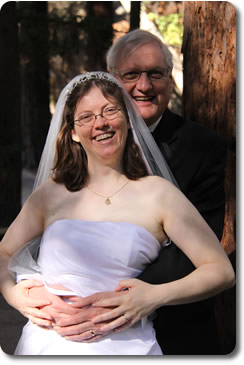 During the time of some private training I did with one of my important craniosacral teachers, William Allen in Boulder, I met the most wonderful man on Earth – Chuck – who is now my husband. Our amazing love for each other grows with every day, and I’m thankful to have such an amazing partner in my life now. Our relationship is so special that I decided to give my well-known practice in Berlin to a colleague, in order to live together with him. I started all over again in Erie, CO, where I opened my new private Practice for Craniosacral Therapy and Birth Integration in November 2010.
During the time of some private training I did with one of my important craniosacral teachers, William Allen in Boulder, I met the most wonderful man on Earth – Chuck – who is now my husband. Our amazing love for each other grows with every day, and I’m thankful to have such an amazing partner in my life now. Our relationship is so special that I decided to give my well-known practice in Berlin to a colleague, in order to live together with him. I started all over again in Erie, CO, where I opened my new private Practice for Craniosacral Therapy and Birth Integration in November 2010.
Our relationship added another dimension to my work with babies and families, and my understanding of pregnancy and birth. We prepared ourselves for conscious conception, invited children to come to us, and enjoyed the pregnancy. But after 16 ½ weeks we lost our baby due to miscarriage and gave birth to him at home together. Healing from this loss expanded my understanding of how I can support other families in a similar situation. And even though 16 ½ weeks was much too early, I still received the mother’s perspective of giving birth, besides the one of a doctor or labor support person.
And I feel a very strong connection to our future children to be. From “talking” with them I received a lot of additional insights about what babies want us to know.
Colorado mountains and the medicine of the future
Living near the mountains and being surrounded by the special mountain energy – as opposed to living in the city of millions, Berlin – makes me more aware of the new paradigm in medicine, which has to include the ancient and forgotten wisdom of energy medicine, helping people to heal from the inside. Listening to symptoms and understanding their messages causes them to change and disappear, and allows for a more profound healing than cutting off the parts that don’t function the way we want them to, or using drugs to cover the symptoms.
The medicine of tomorrow treats patients with respect for who they are: a conscious being in a human body. It facilitates healing from the inside out by combining medical knowledge and experience with listening to the inner wisdom of the body-mind-soul system of the client. And it leads us to the awareness that health starts before conception.
Today we already have a lot of proof of how special health problems are linked to certain conditions in utero. By using this knowledge, we will have access to a healthier way of living from the very beginning.
Craniosacral and Birth Integration Therapy work with the embryologic and healing forces in us. They therefore are one of the doorways into the new paradigm of healing and of birth. They help to start the medicine of tomorrow today.